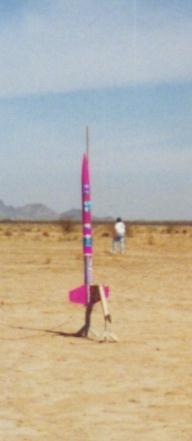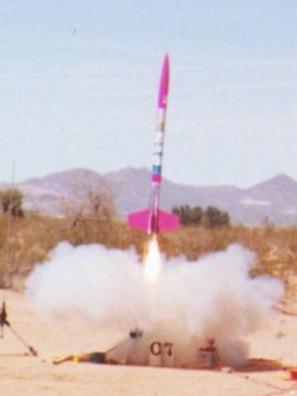Scratch 4H Original Design / Scratch Built
Scratch - 4H {Scratch}
Contributed by Moira Jean Whitlock
| Manufacturer: | Scratch |
 Brief:
Brief:
This rocket was inspired first by my LOC 4 29SS flights with 4 G40's. I
often wondered how to hold a rocket together under higher power. Then I bought
a AAA Model Aviation Fuels Quadra
G which had a strong interlocking fin design and then I had my answer. I'd
use that concept and scale it up. I'd also use Apogee's Rocksim 4.0 to design
the best fin shape and size.
The rocket is called 4-H Project because it can fly on 4 H motors and hopefully 4 J's, if one dares. The rocket has a 4-inch phenolic main body tube 4 feet long and its 4 38mm motor tubes extend 36 inches outward from this tube and hold the fins via the square formation they make.
Construction:
The only hard part was designing the butterfly wings that would interlock to
form a set of 4 fins at 90 degrees to each other. I made the root 9 inches, the
span 8.875 inches, the sweep angle 20 degrees, and the tip 4.5 inches. Each of
the two wings would form two fins, and the fins were separated by a 4 inch
space where they would interlock via grooves and whereby the 4 38mm motor tubes
would rest and hold the structure in fin alignment.
Tools needed required a table saw. My band saw did not have the throat depth to handle the wings, which were too long to go through the throat of the saw. A finishing sander was used to bevel the fins, and medium fiberglass cloth was used to reinforce the connection of the motor tubes together and to the fins. The epoxy used was the 30 minute type. Polyurethane foam was used to hold the lead weights used in the nose cone, as Rocksim predicted that 8 ounces would add to stability. We can add up to 16 ounces if we use heavier motors. This same foam was used to fill gaps formed from the motor tubes fitting into the body tube.
Home Depot carries the 1/4 inch thick birch plywood I used for the fins. Hobby Bench carries the epoxies used and the fiberglass cloth. West Systems Epoxy also carries these products and they're good too. The polyurethane foam can be found at Hobby Bench. It may be found on ROL, but I have not had to search for it there. This is a two part liquid plastic that expands into a foam. It's tricky in that after just 30 seconds, it foams up and will not pour as a foam. So, you have that long to pour it where you want it.
The parachute is a 60-inch Spherachute. The paint job matches the pink and blue of the chute and is mainly pink with blue self adhesive holographic lens paper obtained from American Science and Surplus. This accent makes the rocket sparkle in the sunlight. The finishing touch is a 4-leaf clover in the blue lens paper with a white H on each leaf. The resulting rocket feels strong and is sturdy.
 Flight:
Flight:
Rocksim predicts that with two 38mm H type motors, a delay of 10 is good. With
4, a delay of 12. With 2 J350's, I came up with the long delay being best, as
it would be with 4 J motors. Worm bed wadding plus a Nomex® chute protector will
be used and a 15-foot length of 500-lb Kevlar® cording will be its shock cord.
The shock cord is anchored through a 4-inch centering ring with a 38mm hole,
placed right forward of the 4 motor tubes. A screw eye is used to tie the cord
to the centering ring. A screw eye with a long tail is epoxied into the nose
cone and forms the attachment to the nose cone for the shock cord. I do this
because using the little plastic loops on the nose cones to attach shock cords
has not worked well for me in high power, as the loops break easily under
stress. The rocket is destined for a 2-H test flight in 2 weeks. I will
probably choose 2 H112's.
The design works and kicks butt, if you'll pardon my vernacular. I flew it with two I 357's and it soared. Unexpectedly, it whistled like an incoming bomb going up. maybe it's a fluke or maybe all those built like it will whistle. Everyone liked it. next, I'll try it with 4 motors!!! I'm even head-designing a quad 54mm one. I'm so bad...
As for 4-H, one additional I must add is to thoroughly plug any unused motor tubes. The best way might be spent motor casings. If you don't, gas leaks might occur that prevent parachute deployment. 4-H landed hard because of this. He was built like a bomb, so he will soon fly again. I gave him a new payload section. He's now 7 foot 6, not 7 feet even. The I 357 is a great stump-pulling motor. Next flight just HAS TO have 4 motors!!!
Summary:
A challenge, and funny. I await the reaction from onlookers. It did require an
arsenal of tools and some expensive epoxies and polyurethane foam. But I got a
strong rocket. It was not easy to fit the 4 phenolic motor tubes into the body
tube. In fact, the guys said it couldn't be done. But I did it after gentle
persistence. However, I saw fit to fiberglass the lower airframe tube to
strengthen it when I could see a very slight bulging from the tightly fit motor
tubes.
Other:
If anyone else wants to try this, please tell me what you do for motors. I'm
saving up to get 3 more 38/720 motors one by one so that I can fly this with 4
J350's. Building this rocket taught me that when you fiberglass, you must sand
thoroughly or else every imperfection in the surface will be visible when it's
painted.
UPDATE: if the maker pushes the rocket with J350's, that the fins not be plywood, or trim their size to reduce aerodynamic flexion. At mach, the stress broke the plywood fins right where they interlocked. Mach was heard with a great BOOM. Anyway, I'm making 4-H some G10 fins.
 |
 |